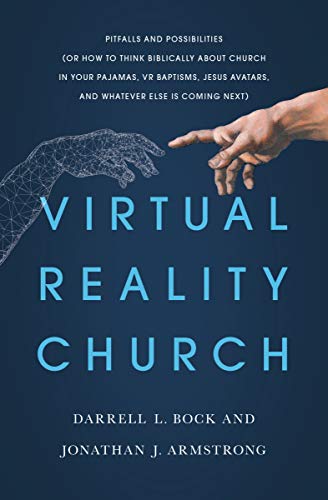“Virtual Reality and its related technologies are going to change our world. If Christians don’t drive the discussion about how this tech gets used . . . who will?” This is one of the many questions that compelled Darrell Bock and Jonathan Armstrong to co-author their latest book, Virtual Reality Church: (Or How to Think Biblically About Church in Your Pajamas, VR Baptisms, Jesus Avatars, and Whatever Else is Coming Next).
As virtual reality has emerged, coupled with the COVID-19 pandemic and the way it changed the world, almost requiring that we reckon with VR and its family of technologies, these questions have entered the church’s calculus sooner than we may have imagined. So, the authors set out to help the church think biblically about the possibilities and pitfalls of integrating virtual reality and other technologies into the life of the church.
Bock, author of dozens of books, is the executive director of Cultural Engagement at the Hendricks Center, where he hosts the “Table Podcast,” and senior research professor of New Testament Studies at Dallas Theological Seminary.
Armstrong is professor of Bible at Moody Bible Institute, teaching in the areas of New Testament language and literature and church history. Additionally, Armstrong consults with Christian colleges and universities on the intersection of education and technology.
Together, Bock and Armstrong have produced a resource in Virtual Reality Church that will undoubtedly compel churches and Christians to think critically about virtual reality’s place in Christian churches.
Technology and the church, past, present, and future
Though the book’s title suggests that Bock and Armstrong deal exclusively with virtual reality, a technology they describe that “allows users to be actors in a digitally created world by their motions and manipulations in the real world” (40), they in fact survey and interact with technology a bit more broadly. And they do so in service of the church. In the opening pages of Virtual Reality Church, the authors state that the two “core goals” of the book are:
(1) to encourage educators and ministers to think about the history of the church’s use of tech and so to be disciplined and flexible in their approach to future use, and (2) to think critically about which processes in education and church life can be improved by increased use of virtual telecommunication and which processes should be kept on campus or conducted in person in the church building (15).
Rather than seeking to win readers with a particular argument or impose their own views, the authors have sought to encourage church men and women to think critically about the history of the church and the future of the church regarding its use of technology.
Though the most cantankerous among us may snub our nose at the growing ubiquity of technology in our sanctuaries, the church has a long history of integrating the up-and-coming technologies that have marked each era of history, from the invention of writing to the printing press to radio and television. Each successive generation of Christians has been in a position to think carefully about its society’s burgeoning technologies and consider if and how to integrate them into the life of the church and the mission of God. Bock and Armstrong argue that the advent of virtual reality is no different.
The questions that Bock and Armstrong pose are not necessarily if virtual reality should be integrated into the life of the church (though that is a valid question), but how and in what environments should ministers and church leaders consider implementing these inevitable technologies. Moreover, the above questions ought not be considered before more foundational questions are asked such as: what is the missional potential of VR and related technologies (53); what might be possible that was not possible before (17); and what do we gain and lose when we apply a new technology or process (17)? These and other questions scattered throughout the book help the reader think honestly about the role that virtual reality and other future technologies may play in the church moving forward.
Two things are certain: the church will not cease to exist, and technology will not cease to advance, and rapidly. The question that this leaves for the church is what use will we make of the advancements of technology for the sake of the advancement of the gospel of Jesus Christ?
Thinking critically about the potential of technology and its pitfalls
Can a church exist in virtual reality? Virtual reality, after all, is not actual reality. This is the question that I skeptically imposed onto Virtual Reality Church before even cracking open the front cover. But that is not a question that the authors are preoccupied with, though they do address it in the book. The driving question, rather, is how an existing church can integrate technology, whether virtual reality or something else, into the life of the church for the sake of its mission. This is a question that churches and Christians in our society should be thinking about.
While the authors are generally optimistic about the possibilities that come with introducing new technologies like virtual reality into the practice of the church, they also recognize that certain pitfalls loom. “Every new technology brings positive and problematic change for the communities who adopt them” (45), they rightly say. Though technology clearly offers great potential for the spread of the gospel and the building up of the global church, I am not sure we’ve yet thought critically enough about some of its pitfalls.
This does not mean that virtual reality or any other technology, for that matter, should be resolutely shunned and evicted from our church buildings. But it does mean, as this book encourages and models, that church ministers and members alike should be actively engaged in an ongoing conversation about the place of technology in the local church. What is a church? What are its nonnegotiables regarding the weekend gathering, the Lord’s Supper, and baptism, for example (which the authors do address)? Where are technologies like virtual telecommunication and virtual reality welcome and unwelcome in the life of the church and its sacred practices? These are the conversations that Virtual Reality Church have kickstarted for us and that we should take back to our local churches for consideration.
“Evangelicalism has existed at the crossroads of tradition and innovation from its inception” (55). The church of Jesus Christ has encountered and utilized technological advancements for the entirety of its history. Though today’s technology is new, the questions we must ask have been asked for millennia by our forebears. Like Bock and Armstrong have modeled for us, and others before them, we should continue to ask and answer today’s questions for the sake of the gospel and the building up of the church.











